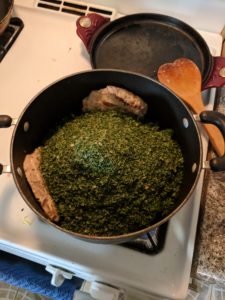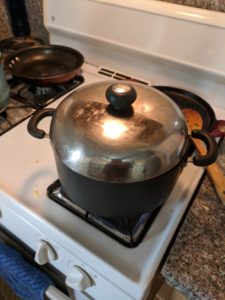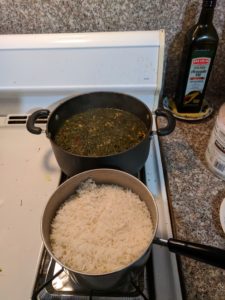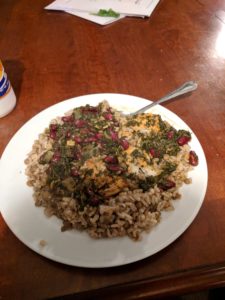

dried herbs: parsley, leeks or green onions, coriander, and dried fenugreek leaves.
1 Onion
2 lbs stew meat or 2 lbs boneless chicken in 3/4 inch cubes
1 teaspoon Turmeric
6 dried limes or 1⁄2 cup fresh lime juice
1⁄3 cup cooking oil
1 cup green onion, finely chopped
1 1⁄2 cups spinach, finely chopped
1 1/2 cup rice (substitute with brown rice if desired)
Directions:
Chop the onion and cook it until slightly brown with the oil, preferably grapeseed or avocado oil. Add the turmeric and stir well. After about 1 more minute, add the meat or chicken and cook until the outside changes color and is cooked, it will cook fully in the water. Soa k the dry herbs 10 minutes prior to adding to the stew. Boil water separately while cooking the meat and onions. Drain the dry herbs and add them to the partially cooked chicken along with the other greens. The dish is traditionally
k the dry herbs 10 minutes prior to adding to the stew. Boil water separately while cooking the meat and onions. Drain the dry herbs and add them to the partially cooked chicken along with the other greens. The dish is traditionally  made with dried lemons or lemon juice, but I forego that step because I do not like the dish to be sour, rather I prefer it on the salty side. Once the water boils in a separate pot, add it to the pot. Once most of the ingredients are in the pot, keep it on high heat until it reaches a rolling boil and stir continuously. Lower the heat to medium-low and keep the lid on the pot tilted until enough water evaporates to get to a stew-like consistency. Stir about every 8 minutes to make sure the herbs do not stick to the bottom or sides. Cooks in about 45-60 minutes depending on the amount of water added. Wash rice three times and add enough water for the level to be up to the second line of your index finger above the rice. Cook on high heat until a rolling boil is achieved. Add salt. Leave it on medium-low until water evaporates.
made with dried lemons or lemon juice, but I forego that step because I do not like the dish to be sour, rather I prefer it on the salty side. Once the water boils in a separate pot, add it to the pot. Once most of the ingredients are in the pot, keep it on high heat until it reaches a rolling boil and stir continuously. Lower the heat to medium-low and keep the lid on the pot tilted until enough water evaporates to get to a stew-like consistency. Stir about every 8 minutes to make sure the herbs do not stick to the bottom or sides. Cooks in about 45-60 minutes depending on the amount of water added. Wash rice three times and add enough water for the level to be up to the second line of your index finger above the rice. Cook on high heat until a rolling boil is achieved. Add salt. Leave it on medium-low until water evaporates.
Background:
My family is from Iran and immigrated to the United States in the 1980s. With themselves, they brought their culture including their language, food, and music. A lot of Iranians migrated to the United States during this time due to the Iranian revolution in 1979. Little by little our extended family followed my parents and together a family community was created. It is common for humans to band together culturally, so the same is true for Iranian Americans. Of course, little by little, parts of American culture found their way into their lives and hearts, but their uniqueness was still their culture. Either way, a fusion began to emerge and it is no longer strictly Iranian or American. Moving forward I will just call the fusion between Iranian culture and American culture: Persian.
The fusion that my parents and extended family invited into their lives included food and cultural elements. For example growing up, my mom was a stay at home mom, and would usually cook Persian food for dinner. But for lunch or as an afternoon snack, fish sticks or peanut butter jelly sandwiches were also common. Culturally my parents integrated some western music and movies such as the Bee Gees and the James Bond series.
The fusion of food and culture that my family created has gone even further with me. I have personally never lived or visited Iran, so my only context of my parent’s culture is from what they have shown and told me about it. In addition, my Persian friends and I, born to Iranian parents but grown up in the United States, have in a way created a new culture for ourselves and in our mind, that is what Persian culture looks like in modern times. We have adapted it to our experience. Sometimes that means that we have resisted the culture, and other times it means we have embraced it. There was a time that I resented being Persian, because I wasn’t the same as everyone else, and I just wanted to fit in. But later in High School and especially after I graduated, I started to embrace my culture and my unique experience. I now enjoy Persian music and food but have given up certain cultural beliefs that I do not agree with. For example, it is common for Persians to “taroof” meaning that they, for the sake of politeness, refuse an offer of generosity even if they want it. It has gone so far that people, without being genuine, offer something, expecting the other to say no. I have given this up while maintaining generosity and politeness because I think it is important to care for oneself as well as others simultaneously.
The food I am sharing with everyone today, Ghormeh Sabzi is one of my favorites growing up and still to this day. It was a special dish growing up for my mom to make because of the effort and time it takes to make it. If done properly and traditionally, it can take about three to four hours, or half a day if done in a slow-cooker. Ghormeh means stew and sabzi means herbs, so Ghormeh Sabzi is an herb stew. Typically it is made with stew meat or lamb, but because both of those meats are expensive and takes a long time to make, I substitute it for chicken. That is one change I have made from the tradition, and the other is making it with canned beans instead of cooking the beans from scratch. The stew takes kidney beans, which can take an hour or longer to make, which adds considerably to the time to cook the stew. So the reason I have attempted to cut time off the dish, even more than my parents (who also buy the beans canned, but use stew meat), is because my life is very busy for cooking and I need foods that can be made quickly and within a specific price range. It takes me about an hour to make this dish, which is too long for most days, so I usually only make it for special occasions, similar to my mom, and I make a ton so I can have it for multiple days.
The traditional culture in Iran is that women go straight from their families home to their husband’s home in married life. It is not common, and still in some places even today, it is not lawful for women to live alone away from family or marriage in Iran. When this move from the family to marriage happens, it is common for women to become pregnant soon after and start a family, leaving little room for jobs and higher education. Of course in modern times, some of that is changing, and women are opting from the tradition to pursue a career, but there is still an expectation that they become housewives and raise the children with the children. Because of this reality, there is a lot of time to cook during the day, and this is typical throughout the Iranian cuisine.
Since in Iran is it more common for women to cook for the family, moms teach their daughters to cook from a young age. It is not common for Persians to use written recipes when cooking or sharing recipes. Recipes are passed down from generation to generation verbally and by learning from other family members. Cooking is a time for bonding and eating together is essential in the culture. It is very common for one family to cook for a large group of people, typically the extended family. Typical conversations at the dinner table revolve around the food and recipes are shared verbally, especially when someone asks, “wow this is so good, how did you make it?” Or, “Why did you add x, y instead of z?” The questions are typically posed with curiosity and not ridicule. At a dinner in the future, perhaps when the guests invite the hosts to their home, they cook the same dish and integrate the way the original host made the dish, or they share an anecdote of when they made it the way the original host made it, and how pleased they were with their method of cooking. There is a lot of respect and admiration for food and how each family makes it differently.
Because of the conversations revolving around food while I was growing up, I love cooking for my friends and family. I get a lot of enjoyment from cooking for people and try to add a key ingredient in every dish I make for people: love. Home cooked meals are greatly preferable to eating out. Of course, I enjoy food from restaurants, especially for food that I do not know how to make, or take too much time and effort to make. But when I cook for people or they cook for me, it means a lot to me because of the effort and time it takes to show one another that we care. As a kid, this wasn’t the case. I used to beg my parents to let us eat at my favorite fast food restaurant: Taco Bell. But they would always remark that we have food at home, and why waste money on outside food? So when I moved out on my own, I ate a lot of fast food, to the point that I got sick of it, and learned for myself, the value of home cooked food with love.
On March 9, 2018, I made this dish for the people living in my house. Most of us are currently fasting for the 19 day Baha’i Fast. We cannot eat or drink liquids from sunrise to sunset daily. So we decided to have a potluck dinner together to enjoy when the sun goes down. I made this dish in the last hour of the fasting period for that day, and the smells that the food released made all of our mouths salivate in anticipation of devouring all the food being prepared. It was very nice to eat together, and an honor to cook for them.
Nutritional Benefits of the Herbs in Ghormeh Sabzi:
“Fenugreek is indigenous to the eastern shores of the Mediterranean Sea, but it is grown in India, Morocco, Egypt, and England…The seeds are also soaked and then powdered and used to make lip balm and tonic. The seeds can be used to make tea, which can reduce fever and menstrual pains, or they can be used in an ointment to treat skin infections…Fenugreek’s leaves, which are high in iron, are (also) used in salads.”
“Spinach is a rich source of vitamin A, C, and iron.
Parsley is an antioxidant, detox remedy, diuretic, antiseptic and anti-inflammatory agent.
Green Onions are high in vitamin K and C. “These nutrients both offer benefits for the health of your skeleton — vitamin C helps you synthesize the collagen that keeps your bones strong, while vitamin K helps your body utilize the calcium it needs to maintain bone density. Vitamin K also controls blood clotting, while vitamin C acts as an antioxidant and protects your tissues from damage.”
Kidney beans nutrition is packed with dietary fiber, starch, antioxidants and phenolic acids. Kidney beans are an awesome source of iron, manganese, folate, phosphorus, potassium, and magnesium.
Turmeric is a great source of anti-oxidants and helps with memory and intelligence.
Final Product:


 Take a generous portion of rice and pour Ghormeh Sabzi all over the rice. Salt to taste. Enjoy with yogurt or by itself.
Take a generous portion of rice and pour Ghormeh Sabzi all over the rice. Salt to taste. Enjoy with yogurt or by itself.
References:
- Mollypaul. (2008, July 09). Ghormeh Sabzi – Persian Green Stew Recipe – Genius Kitchen. Retrieved March 10, 2018, from http://www.geniuskitchen.com/recipe/ghormeh-sabzi-persian-green-stew-313055
- Wikipedia. (2018, March 03). Ghormeh sabzi. Retrieved March 10, 2018, from https://en.wikipedia.org/wiki/Ghormeh_sabzi
- Babcock, J. (2017, June 13). Parsley Benefits, Nutrition & Recipe Ideas. Retrieved March 10, 2018, from https://draxe.com/parsley-benefits/
- Tremblay, M. S. (2017, October 03). Are Green Onions Healthy? Retrieved March 10, 2018, from https://www.livestrong.com/article/354600-are-green-onions-healthy/
- Axe, D. (2017, June 14). Top 5 Benefits of Kidney Beans Nutrition Kidney Beans Recipes. Retrieved March 10, 2018, from https://draxe.com/kidney-beans-nutrition/
- Gunnars, K. (2017, June 9). 10 Proven Health Benefits of Turmeric and Curcumin. Retrieved March 10, 2018, from https://www.healthline.com/nutrition/top-10-evidence-based-health-benefits-of-turmeric#section4
